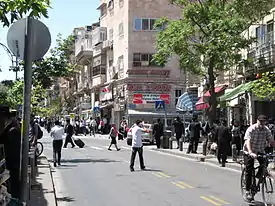
Malkhei Yisrael Street (Hebrew: רחוב מלכי ישראל, Rechov Malkhei Yisrael, lit. "Kings of Israel Street"), also spelled Malchei Yisrael, is an east–west street in the Geula neighborhood of north-central Jerusalem. Its eastern flank, which abuts Mea Shearim Street at an intersection called Kikar HaShabbat (Sabbath Square), is the main shopping district for Haredi Jewish residents of northern Jerusalem. The remainder of the street, which extends to Sarei Yisrael Street at its western end, includes the historic Schneller Compound and numerous Haredi and Hasidic yeshivas, girls' schools, and synagogues.
Name
The street was originally called Geula Street and was the commercial center for various pre-World War I communities such as Kerem Avraham, Yagiya Kapayim, Zikhron Moshe, Batei Horenstein, and the Achva neighborhood.
The name Malkhei Yisrael (Kings of Israel) refers to the three kings of Israel, Saul, David, and Solomon.[1]
Urban commercial district
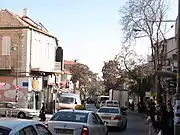
The eastern end of Malkhei Yisrael, which is the heart of the Haredi commercial district for northern Jerusalem,[2] has been called "the ultra-Orthodox Oxford Street".[3] Spanning approximately 300 metres (980 ft),[4] and branching out into the side streets,[2] this area is noteworthy for its huge volume of foot traffic and the high cost of commercial space – rent per square meter is equal to or greater than that of commercial space in Israel's major malls.[4] Many stores are open from 10 a.m. to 11 p.m.,[4] and the street is especially crowded on Thursday nights, summer nights, and the eve of Jewish holidays. Traffic on the two-lane street often comes to a standstill throughout the day, as in addition to cars and delivery trucks, bus lines serving northern Haredi neighborhoods and Rachel's Tomb ply the street. The weekday hubbub only ceases on Friday afternoon before the advent of Shabbat,[5] while on Friday nights, Malkhei Yisrael and neighboring streets are filled with Hasidic Jews and tourists walking on foot to the various Hasidic courts in and around Geula.[6]
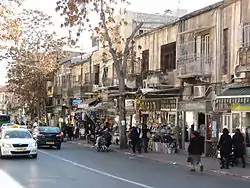
There are no indoor malls on this street;[4] rather, the avenue is lined with dozens of small shops that sell essential consumer goods such as "clothes, food, school supplies, medicine, and limited luxuries" to the Haredi community.[3] There are kosher music stores, kosher pizza shops, home appliance stores, falafel and juice stands,[7] a kosher ice cream parlor,[8] pharmacies, photo shops, a teenage novelty store, Judaica sellers,[9] kosher bakeries, and a shtiebel with continuous minyanim.[10] All food stores carry reliable hechsherim (kashrut certificates) to appeal to the Haredi clientele, which often shops with children in tow.[4] In the weeks before Sukkot, numerous stores vacate their premises and rent their space to etrog dealers,[11] while sidewalk vendors sell etrogs, lulavs, sukkah decorations and pictures of rabbinical figures.[12] As a central Haredi shopping district for both locals and tourists, Malkhei Yisrael Street is also populated by a number of street beggars, some of whom have been working the street for decades.[10]
Schneller Compound
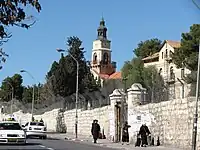
The Schneller Compound, located along the center section of Malkhei Yisrael Street behind a long stone wall, predates all of the streets and neighborhoods surrounding it. The land was purchased in 1855 by Father Johann Ludwig Schneller, a Lutheran missionary, as a family estate. Following an 1860 massacre of thousands of Maronite Christians in Lebanon and Syria by Lebanese Druze, Schneller rescued nine Christian boys and established an orphanage on his property.[13] By the time of Schneller's death on 18 October 1896, 1500 children had passed through the orphanage's doors.[14] By 1903 this educational facility had grown to eight buildings and included an orphanage, a school for the blind, and vocational workshops for youth.[15] The compound was taken over by the Turkish army as an army barracks during World War I,[15] by the British during World War II, and by the Haganah during the 1948 Arab-Israeli War.[13] After that, it was used as a base for the Israel Defense Forces and an army clinic for 60 years.[16] In 2008 the army base was relocated to the Ofrit base near Mount Scopus.[17]
In November 2010, the Schneller grounds were designated as a public parking lot by the municipality to ease the parking problems in Geula. One hundred parking spaces were made available for up to 3 hours.[18]
In 2011 the Israel Land Administration approved plans for the development of 218 luxury apartments on the property while preserving the eight original orphanage buildings.[17]
Geological Survey of Israel
The Geological Survey of Israel has operated next to the Schneller Compound since 1949. This government institute is involved in earth science research and development.[19]
Present-day landmarks
Schools
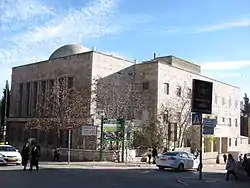
- Bais Yaakov Teachers Training Seminary[20]
- Midreshet Rachel Women's Seminary
Yeshivas
- Ateret Yitzchak yeshiva gedola
- Be'er HaTalmud yeshiva
- Brisk yeshiva
- Chayei Olam yeshiva[21]
- Porat Yosef Yeshiva[22]
- Talmud Torah Mesilat Yesharim
- Tiferet Yisrael yeshiva[23]
- Yakirei Yisrael yeshiva
Synagogues
Other uses
Malkhei Yisrael Square is the former name of Rabin Square in Tel Aviv.
References
- ↑ Eisenberg, Ronald L. (2006). The Streets of Jerusalem: Who, what, why. Devora Publishing. p. 245. ISBN 1-932687-54-8.
- 1 2 Hyman, Benjamin; Kimhi, Israel; Savitzky, Joseph (1985). Jerusalem in Transition: Urban growth & change, 1970's-1980's. The Institute of Urban and Regional Studies, The Hebrew University of Jerusalem. p. 9.
- 1 2 Carmeli, Yoram S.; Applbaum, Kalman Applbaum (2004). Consumption and market society in Israel. Berg Publishers. p. 90. ISBN 1-85973-689-0.
- 1 2 3 4 5 Nahum-Halevy, Ranit (15 June 2009). "Jerusalem's Hottest Commercial Strip". Haaretz. Retrieved 5 December 2011.
- ↑ Response: A contemporary Jewish review, Volume 16. 1988.
- ↑ The American Zionist, Volume 63. Zionist Organization of America. 1972. pp. 16–17.
- ↑ Vered, Ronit (13 September 2007). "5 stops in Mea She'arim". Haaretz. Retrieved 5 December 2011.
- ↑ Spodek, Yaffi; Tapper, Josh (2010). "Get Your Kosher Ice Cream: A new parlor draws crowds and critics". Journey to Jerusalem. Retrieved 5 December 2011.
- ↑ Carmeli and Applbaum, Consumption and Market Society in Israel, pp. 81–82.
- 1 2 Ginsberg, Rachel. "Hey, Got A Shekel For A Schnorrer?: Schnorring, sticking your hand out and yelling 'tzedakah' to passersby, is actually a fine art, according to Super Schnorrer, an icon of Malchei Yisrael Street in Geula for the past 32 years. While most people would be humiliated to jangle their cup and beg, Super Schnorrer says his ego disappeared long ago – and besides, aren't all fundraisers just schnnorrers with ties?". Mishpacha Supplement, "A Face & A Place … Hear Their Stories", Sukkot 5772 (2011), pp. 16–22.
- ↑ "The Most Colorful Streets in Jerusalem". Streets of Jerusalem. 25 September 2007. Retrieved 5 December 2011.
- ↑ Assaf, Efrat. "A few days before Succot, I toured Mea Shearim & Geula". All About Jerusalem. Retrieved 5 December 2011.
- 1 2 Bar-Am, Aviva. "Jerusalem Area Tours: A guide to buildings in Jerusalem". The Jerusalem Post. Archived from the original on 24 February 2012. Retrieved 5 December 2011.
- ↑ Ben-Arieh, Yehoshua (1979). עיר בראי תקופה: ירושלים החדשה בראשיתה [A City Reflected in its Times: New Jerusalem – The Beginnings] (in Hebrew). Jerusalem: Yad Izhak Ben-Zvi Publications. p. 447.
- 1 2 Eylon, Lili (2011). "Jerusalem: Architecture in the late Ottoman Period". Jewish Virtual Library. Retrieved 5 December 2011.
- ↑ Chinkis, Binyamin. "A Peek Behind the Gates of the Schneller Compound". Hamodia Israel News, 2 July 2009, pp. A22–A23.
- 1 2 Spielman, Sarah. "Merom Yerushalayim at Schneller's: From estate to military camp…to estate once more". Hamodia, 24 November 2011, pp. A16–A17.
- ↑ "Israel News", Hamodia, 4 November 2010, p. A15.
- ↑ "About Us". Geological Survey of Israel. Retrieved 5 December 2011.
- ↑ "Teachers Training Colleges". Israel Ministry of Absorption. Retrieved 5 December 2011.
- ↑ Rossoff, Dovid (1998). Where Heaven Touches Earth: Jewish life in Jerusalem from medieval times to the present. Guardian Press. p. 348. ISBN 0-87306-879-3.
- 1 2 Levinger, I. M.; Neuman, Kalman (2007). Israguide 2007/08. Feldheim Publishers. p. 259. ISBN 978-1-59826-154-7.
- ↑ Rossoff, Where Heaven Touches Earth, p. 526.